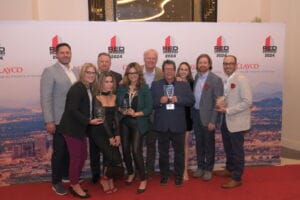NAIOP, a commerical real estate development group, has historically focused on industrial and office sectors. However, the national organization is extending its membership benefits to more obviously include retail developers and similar commercial professionals.
“The organization really started shifting gears more than 10 years ago,” says Thomas Bisacquino, CEO of NAIOP. “It was in 2005 that the association held a big series of mixed use summits.”
In 2009, NAIOP dropped the words behind its acronym, which stood for National Association of Industrial and Office Parks. Now the group simply goes by NAIOP, Commercial Real Estate Development Association.
“The reason we did that is because the association was more associated with the process of development and ownership than any one product type,” Bisacquino says. “Our roots are in office and industrial, but our members are doing so much more.”
According to NAIOP’s membership data, 67 percent of its members are involved in retail development. Likewise, 66 percent of NAIOP members also report work in mixed-use development. It’s not necessarily the mixed-use component that’s grabbing Bisacquino’s attention. It’s the way the product mix has changed over the years. When mixed use projects were planned in previous decades, they led with office. Now, he says, they’re leading with multifamily and retail, to be followed by office.
“The industry was naturally headed in the direction of mixed use,” says Bisacquino. “The lines are starting to blur between traditional urban and suburban development. Society is pushing the envelope.”
When it comes to pushing NAIOP’s envelope, members of the organization can expect something different than what the International Council of Shopping Centers (ICSC) offers, Bisacquino says. ICSC is the largest commercial real estate group solely focused on the retail industry.
“(Retail) has been something we’ve been doing for quite some time but has unfortunately been the best-kept secret in town,” Bisacquino says. “We recognize there’s clearly a misperception it isn’t the home for the retail business when it is.”
Ed Beeh, executive vice president of SRS Real Estate Partners, a retail consulting and brokerage firm, has been a member of International Council of Shopping Centers since 1989.
Beeh says his ICSC membership is sustained by networking and educational events as well as access to political action committees. Though he’s not a member of NAIOP, he has attended the group’s social events.
“The ‘I’ and the ‘O’ (used to) stand for industrial and office, so the perception is that this organization is not focused on or beneficial to retail,” he says.
The changing market, though, he says, could make NAIOP more attractive to the retail sector.
“The line between retail and office is getting more and more blurred with the increased popularity of mixed-use, infill developments,” Beeh says. “Additionally, retailers need distribution and warehousing facilities, so there is obviously a connection between the retail and industrial disciplines.”
Brokers, however, are probably going to stay more involved in ICSC for now.
“NAIOP is a fine organization, and if they are going to include retail and be more inclusive with that industry we would consider (joining),” says Dave Cheatham, president of Velocity Retail and member of ICSC since 1984. “However, if they are going to continue to focus on warehouses and high rises and those matters concerning the office and industrial industry, then we would most likely not see a benefit.”
With the growth of mixed use properties, office and residential developments are increasingly including ground floor retail amenities for the sake of residents and employment base. This is where the brokers may see value, Beeh says.
“(Joining NAIOP) would help build better relationships between the retail and office/industrial sector players and cause more collaboration,” he says.
:This evolution we are experiencing is fairly recent, and I don’t know that retail building owners nor office/industrial owners expanded outside their discipline very often, nor were any of them as interested in collaborating with the others on a platform such as NAIOP,” says Phil Breidenbach, executive vice president, Colliers International in Greater Phoenix, and 20-year NAIOP Arizona member. “That has obviously changed.”
Bisacquino adds that ICSC is transaction-oriented, whereas NAIOP is solely focused on development issues.
“For the first time, we’re seeing a more interesting nexus between industrial and retail,” he adds, in a nod to the transition Beeh mentioned.
“Many NAIOP members expanded their portfolios as some of the lines blur between industrial and retail, thanks to e-commerce,” Breidenbach says.
Velocity Retail Senior Vice President Mike Fitz-Gerald, says he feels that retail and office will integrate further and there will be a need to have a more integrated organization that is equal parts retail, office and industrial. Fitz-Gerald estimates it will be closer to five or 10 years before this happens.
“As our market changes and the retail market evolves into more integrated projects that this association will certainly need to incorporate retail on a higher level,” he says.
The Arizona chapter, according to 2015 Chairman Tom Johnston, managing director at Voit Real Estate Services, plans to host a roundtable discussion about retail’s involvement in NAIOP.
“There’s a lot of retail professionals out there who are already members of NAIOP,” he says, adding that NAIOP’s recent advocacy benefitted retail development through fighting impact fees for the trolley system in Tempe. “Until we get some feedback from them, I can’t say exactly how they will benefit. I can say, on a whole, retail will.”
Johnston, a third-generation Arizonan, lives in downtown Phoenix, as does his daughter, and he says he constantly sees room for development in the urban core that will bring together the office, retail and multifamily sectors.
It’s not a hard sell.
“I think for the sophisticated owner, broker and developer, I think they see the benefit in joining and the collaborative effort with office and industrial developers,” Johnston says.
Breidenbach adds that NAIOP-AZ’s advocacy also benefits the retail sector.
“NAIOP also played a key leadership role in passing legislation signed by the governor that prevents cities from enacting ordinances that require property owners from tracking and publicly reporting their energy usage so owners can be shamed or face significant monetary penalties for reporting non-compliance,” he says. “This would have been especially onerous to shopping centers and larger retail boxes who often have to keep their air conditioners on for longer periods than say a comparable-sized office building, given their working hours with customers.”




